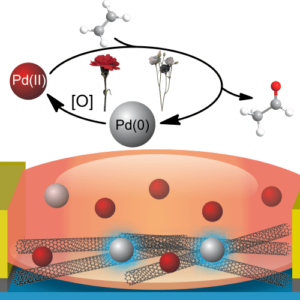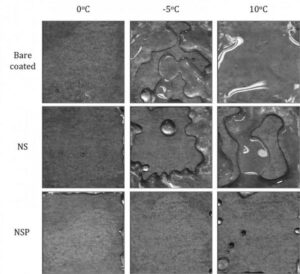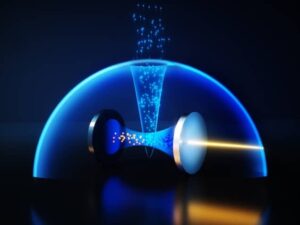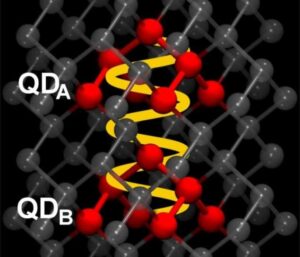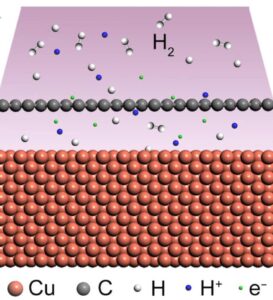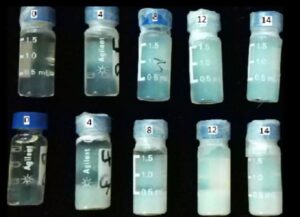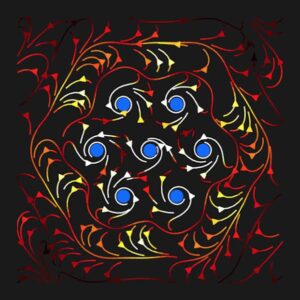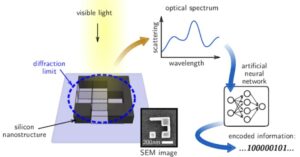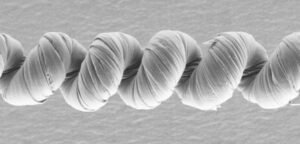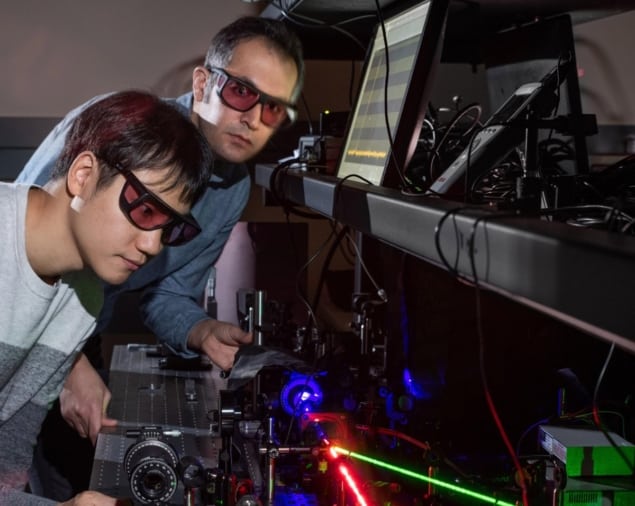
A way of using light to convert a normal optical material into a frequency doubler has been developed by Mohammad Taghinejad and colleagues at the Georgia Institute of Technology. The technique could have a range of applications from creating all-optical information-processing devices to studying quantum-mechanical tunnelling.
Frequency doubling is an optical effect that occurs in spatially asymmetrical materials that have a second-order nonlinear susceptibility. Two photons with the same frequency can interact with the material and combine to form a single photon with twice the frequency of the original photons. While most crystalline materials do not have the appropriate asymmetry in the bulk, frequency doubling can occur at surfaces and interfaces. However, relying on these very thin regions is not ideal for creating practical devices.
Researchers have managed to create bulk materials with the appropriate asymmetries by applying mechanical strain or electrical signals to materials that are normally symmetric. Now, Taghinejad and colleagues have come up with a way of creating a temporary asymmetry in titanium dioxide by applying laser light.
Gold triangles
The team’s device comprises a 25 nm-thick film of amorphous titanium dioxide – normally a symmetric material – that is sandwiched between an opaque gold film and an array of thin gold triangles. When illuminated by picosecond pulses of red laser light, electrons in the triangles gain energy and some of these “hot electrons” move onto the titanium dioxide via the triangle tips. This momentarily breaks the material’s symmetry. Pulses from an infrared laser are also fired at the device and analysis of the reflected light reveals the presence of frequency-doubled blue photons.
While the asymmetry was induced almost instantaneously within the titanium dioxide film, the team found that the second-order effects endured for several picoseconds after the red pulse ended. They also showed that their setup was dynamically tuneable, with the number of migrating electrons depending on laser intensity. Furthermore, they found that the effect can be sustained using a continuous laser beam.
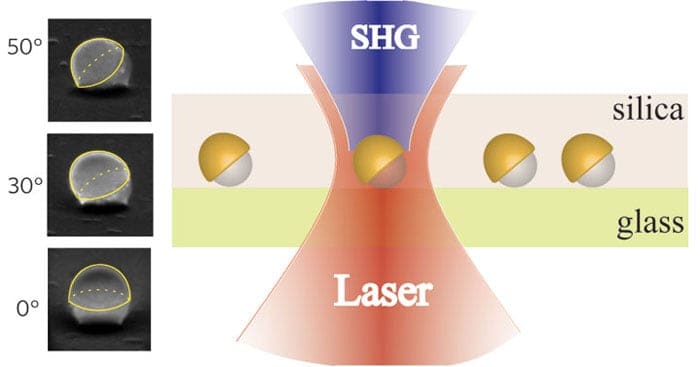
Tilting ‘nanocups’ double optical frequencies
This is the first example of asymmetry being created using optical techniques alone and the discovery could lead to a wide range of scientific and technological applications. The ability to use one light signal to control frequency doubling in another would be very useful for creating all-optical components for computing and telecommunications. Other potential applications of the technique include monitoring the quantum-mechanical tunnelling of electrons.
In future studies, Taghinejad and colleagues plan to explore how the strength of second-order effects can be maximized through certain combinations of metals and semiconductors; using different material shapes; and using lasers with different frequencies.
The research is described in Physical Review Letters.
- SEO Powered Content & PR Distribution. Get Amplified Today.
- PlatoData.Network Vertical Generative Ai. Empower Yourself. Access Here.
- PlatoAiStream. Web3 Intelligence. Knowledge Amplified. Access Here.
- PlatoESG. Automotive / EVs, Carbon, CleanTech, Energy, Environment, Solar, Waste Management. Access Here.
- BlockOffsets. Modernizing Environmental Offset Ownership. Access Here.
- Source: https://physicsworld.com/a/photon-frequency-doubler-is-controlled-by-light/
- :has
- :is
- :not
- $UP
- 160
- 84
- a
- ability
- After
- alone
- also
- an
- analysis
- and
- Another
- applications
- Applying
- appropriate
- ARE
- Array
- At
- BE
- Beam
- been
- being
- between
- Blue
- breaks
- by
- CAN
- certain
- colleagues
- combinations
- combine
- come
- components
- comprises
- computing
- continuous
- control
- controlled
- controls
- convert
- could
- create
- created
- Creating
- demonstrate
- Depending
- described
- developed
- device
- Devices
- different
- discovery
- do
- double
- doubling
- dynamically
- effect
- effects
- electrons
- energy
- example
- explore
- Film
- First
- For
- form
- found
- Frequency
- from
- Furthermore
- future
- Gain
- Georgia
- Georgia Institute of Technology
- Gold
- Green
- Have
- How
- However
- HTML
- HTTPS
- ideal
- image
- in
- include
- information
- instantaneously
- Institute
- interact
- interfaces
- into
- issue
- jpg
- laser
- lasers
- lead
- Lee
- left
- light
- managed
- material
- materials
- max-width
- mechanical
- Metals
- migrating
- migration
- monitoring
- most
- move
- normal
- normally
- now
- number
- occur
- of
- on
- ONE
- opaque
- or
- original
- Other
- Photons
- Physics
- Physics World
- plan
- plato
- Plato Data Intelligence
- PlatoData
- potential
- Practical
- presence
- pulse
- range
- Red
- reflected
- regions
- relying
- research
- researchers
- Reveals
- review
- rob
- same
- scientific
- Semiconductors
- setup
- several
- shapes
- showed
- Shows
- Signal
- signals
- single
- some
- strength
- studies
- Studying
- sustained
- team
- tech
- techniques
- technological
- Technology
- telecommunications
- temporary
- that
- The
- their
- These
- they
- this
- Through
- thumbnail
- tips
- Titanium
- to
- true
- Twice
- two
- use
- using
- very
- via
- was
- Way..
- when
- while
- wide
- Wide range
- with
- within
- world
- would
- zephyrnet

